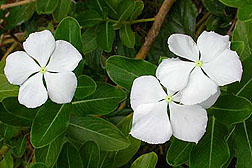This page has been archived and is being provided for reference purposes only. The page is no longer being updated, and therefore, links on the page may be invalid.
|
|
|
|
Periwinkle Plants Provide Ammunition in the War on Citrus Greening
By Dennis O'BrienApril 26, 2010
A team of scientists from the Agricultural Research Service (ARS) and the University of Florida Indian River Research and Education Center have turned an ornamental plant into a tool for combating a bacterial disease that threatens the world’s citrus crop.
Periwinkle (Catharanthus roseus) has proved to be an effective screening tool for treatments to control Huanglongbing (HLB), according to Yong-Ping Duan of the ARS U.S. Horticultural Research Laboratory (USHRL) in Fort Pierce, Fla.
HLB, also known as citrus greening, is one of the most destructive diseases of citrus worldwide. Caused by three closely related species of bacteria, there is no known cure for HLB and no established effective treatments. It remains a threat not only to the citrus industry in Florida, where it was discovered in 2005, but to citrus nationwide. The search for controls has been hampered in part because infected citrus plants are difficult to regenerate and study.
Duan and his colleagues have found that periwinkle performs well as a stand-in for citrus, becoming quickly infected with HLB bacterium and responding well to antibiotic compounds tested to reduce infection. Duan’s colleagues included William W. Turechek and Ed Stover, both at USHRL, and Mu- Qing Zhang, Lijuan Zhou and Charles A. Powell of the University of Florida Indian River Research and Education Center.
The researchers used HLB-infected lemon trees to infect periwinkle plants by way of dodder and then ran greenhouse experiments to find the optimal nutrient and soil treatments for regenerating periwinkle with high infection rates. They also soaked infected periwinkle cuttings in different chemical compounds and found that two of them performed well as potential HLB treatments.
The team published the results in the journal Phytopathology. Duan emphasized that the results are limited to greenhouse settings and that the chemical compounds, penicillin G sodium and biocide 2,2-dibromo-3-nitrilopropionamide (DBNPA), must still be evaluated in field trials and approved for use by regulatory agencies before commercial use is possible.
ARS is the principal intramural scientific research agency of the U.S. Department of Agriculture (USDA). The research supports the USDA priority of promoting international food security.

